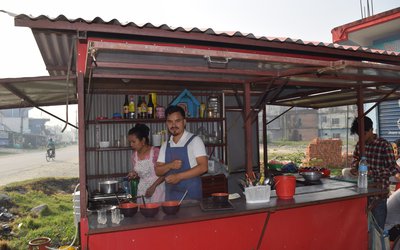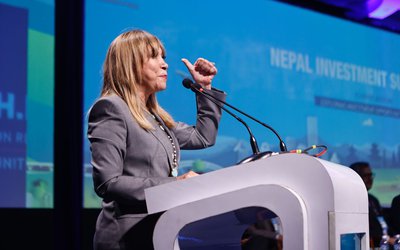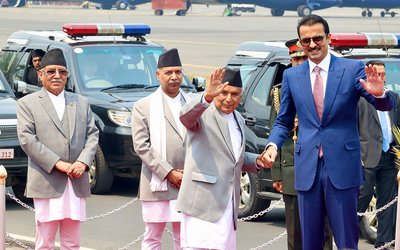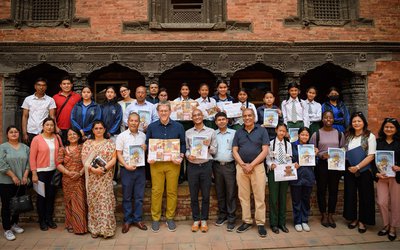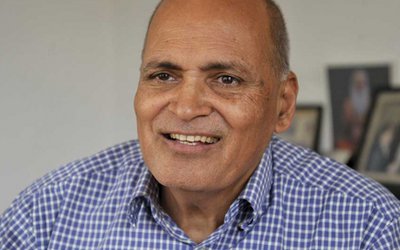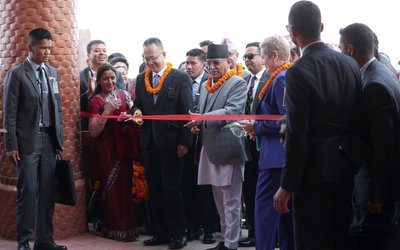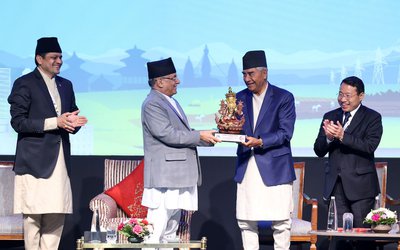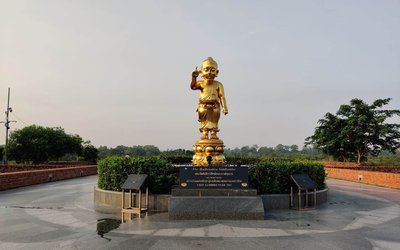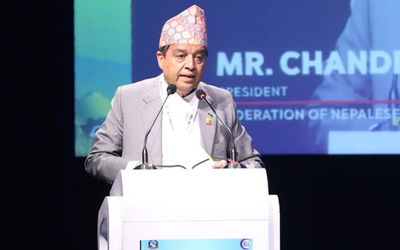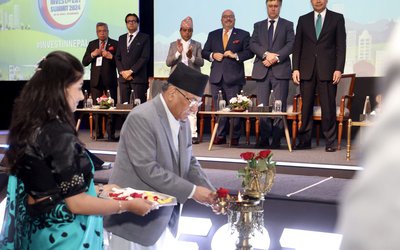A micro-hydro scheme has drastically changed the livelihood prospects of villagers at Pinthali village in Kavre district. The micro-hydro, built under the UNDP’s Rural Energy Development Program (REDP), is providing clean energy to more than 200 households.
Community users’ group, village development committee and district development committee are involved in the scheme as part of the REDP. The model of development planning focuses on gender, social inclusion and post-conflict environmental rehabilitation.
Despite the increase in the number of households with access to electricity over the last five decades, only less than 30 percent of rural households and only 2,100 of Nepal's 3,915 VDCs are connected to the national electricity grid. Thanks to Nepal’s topography, it is costly to connect the rest of the villages in the national grid. Micro-hydro can be a viable substitute.
Since 1996, UNDP's Rural Energy Development Program has successfully demonstrated a community-managed model for extending access to renewable sources of clean energy in rural areas. According to experts, this long-running project takes a holistic approach. It both supports the installation of new energy sources and helps build the supporting policies, institutions and capabilities at the national, district and community levels to sustain progress.
This is not the only program supported by UNDP. The development agency has already contributed many programs directly helping uplift the life of the rural population. UNDP work in Nepal ranges from micro-hydro to building inclusive constitution, and many others in between, such as poverty focused initiatives aimed at achieving the MDGs, reversing the spread of HIV, increasing employment and conserving the environment.
Similarly, UNDP is also focusing its program towards MDGs to provide equitable share between men and women, between Nepal’s diversity of caste and ethnic groups and between rural and urban communities. UNDP support continues to target the traditionally disadvantaged sections of the society.
Past
The observations by Tony Hegan, a prominent supporter of Nepal’s development, in his report Observations on Certain Aspects of Economic and Social Development Problems in Nepal, are a reminder of the harsh reality of the past. After his appointment by United Nations Program of Technical Assistance in 1958 to prepare a development strategy for Nepal, Hagen presented the report to the Nepal government, covering 14,000 kilometers of distance on foot.
“The economic pattern of Nepal is unique so far as the 8.4 million people of the country live in the same way as they did several years ago… The most characteristic fact is the lack of a transport system in the greater part of the country. The whole of the midlands are covered only by trails. Links between the districts and Kathmandu are rather hazardous. Out of ten wireless stations, which were established some years ago, eight are out of order just now. Only a few post office connections are working,” he writes.
“The writer found valleys in the far north-west of Nepal in which the name of ‘Kathmandu’ was even unknown. There are very few schools in the country side, medical services are lacking except a very few stations. Electricity is, of course, not known in the countryside,” Hagen observed in his report presented to Nepal government.
The situation is different now. Prepared with technical support of the United Nations Development Program (UNDP), the Millennium Development Goals Needs Assessment Report for Nepal 2010, which indicated that the country is on the right track to achieve most of its targets by 2015, shows Nepal’s progress in about 50 years.
Growing Gap
Despite many achievements in the development sectors, gloomy pictures paint certain aspects of the development. In terms of distribution of the development achievements, the gap is growing.
“The development gains that Nepal has experienced in the past decade have not benefited all Nepalese equitably as some social groups continue to fall far behind the national average. The percentage of poor among Dalits is 42 percent as compared to 23 percent among the non-Dalits for example. With today’s welcome emphasis on results-based development, our focus must not only be on the means, i.e. equity, but also the outcome of development work, i.e. equality, that we want to achieve, for all,” said Robert Piper, UNDP’s country representative.
When UN’s first agency FAO came to Nepal in the 1950s, Nepal was virtually in isolation with high infant mortality rate, literacy just a little over 3 percent and only couple of hospitals and livelihood based on subsistence agriculture.
When UNDP commenced its operation in Nepal in 1963 by sending specialists in the field of public administration, Nepal’s Human Index was very poor and Nepal’s technical and institutional capability was virtually none-existent. Since then a number of other UN agencies have set up offices in Nepal supporting Nepal’s various development efforts during the last five decades. With major assistance from Nepal’s donor partners like UNDP, the country has made important gains.
“The support given by UN agencies, particularly UNDP, is very important in the overall development of Nepal. The program directed to poverty alleviation is one of the most important ones. The resources and technical expertise played an important role in Nepal’s transformation,” said Dr. Jagadish Chandra Pokharel, former vice chairman of National Planning Commission. “UNDP’s support is more important in the context of enhancing Nepal’s technical capability.”
Other vice chairperson Dr. Dinesh Chandra Devkota said, “Nepal’s human development index has drastically improved as the country has benefited a lot from the development expertise of UNDP and UN agencies. Along with supporting Nepal’s development efforts, UN’s support to Nepal’ peace process and election for the Constituent Assembly is another example.”
New Challenges
Despite the improvement in the human indicators like education, health and other infrastructure, the growing inequalities have now emerged as a major challenge. The recently released UNDP Human Development Report reveals that the deep inequalities threaten the progress of the poor.
According UNDP’s HDI, the importance of understanding the links between sustainability and equality is especially relevant to Nepal which has seen increasing gap in equality even when poverty reduction has been significant.
Nepal has been passing though a series of political instability since the 1950s while experimenting various forms of political systems, including the multi-party, partyless, and federal democratic ones. Despite such shifts in the process, Nepal has made progresses in road, power, education, health and other social sectors. The UN team has always remained the front runner for Nepal’s development.
“As the UN country team, we strongly believe we remain more than relevant in the Nepal Context and our most important results in Nepal this year past, are those we have achieved along-side the Government,” said Robert Piper, UN resident and Humanitarian Coordinator for Nepal.
Nepal has made significant progress on a number of the Millennium Development Goals over the past years. Nepal is on track to achieve many of the targets except those related to full and sustained employment, hunger, education and the environment. The preliminary results of the third National Living Standard Survey have also shown that Nepal has significantly registered improvements in many areas, including average household income and per capita income. The achievement is nothing short of extraordinary, given the country’s post-conflict status and the country’s difficult political and economic environment.
If the peace is to stay, Nepal needs the right kind of development, the kind that reaches Nepal’s most disadvantaged population, that delivers basic services and livelihood opportunities to communities and regions, that address those left behind vis-à-vis the improving national average and the kind of development to deliver the Millennium Development Goals and build peace at the same time.
Foreign Aid and Politics of Nepal: A Case Study by Eugene Bramer Mihaly, published in 1965, highlights the relevance of UN agencies, arguing that UN support is neutral compared to aid from other countries. Like in the period of early 1950s when the United Nations, which first got involved in development efforts in Nepal in 1952 in agriculture and health through FAO and WHO, the focus is still on people.
The UNDP and other UN agencies play an important role in the development of Nepal. For over five decades, the United Nations provided a broad range of services in order for the Nepalese people to attain self-reliant and sustainable development leading to a higher standard of living.
The United Nations and Nepal achieved many results, new skills were acquired, essential development institutions were built and strengthened, new technologies were transferred and adapted and the people’s living conditions were raised as a result of numerous programs in the social and productive sectors. With the mobilization of more than thirty specialized agencies and a variety of UN programs and funds, United Nations continues to support Nepal’s pursuit of a better life for its people.
As in the Kavre district, UNDP in Nepal concentrates its efforts for greater impact in the most remote, poor, and/or conflict-affected areas of the mid- and far-western development regions and the Terai, where its rights-based interventions are targeted towards the disadvantaged and vulnerable groups. The UNDP programs seek opportunities for joint programming with other United Nations organizations and engage in joint planning and monitoring of development activities in selected districts.
As it always places people at the center, the UNDP programs are prepared in consultation with the Government, civil society organizations, United Nations organizations and other development partners, and appraised at a joint strategy meeting.
As the Government coordinating agency, the Ministry of Finance heads the Country Program Board, which guides the implementation of the Program and the cross-sectoral linkages are ensured through outcome boards. The implementation guidelines are revised in line with the results management guidelines, to support national ownership and accountability.
UNDP’s priority in are Nepal are Transitional Governance, Inclusive Growth & Sustainable Livelihood, Peace Building and Recovery, Energy, Environment and Natural Disaster Management and HIV/AIDS
Where does UNDP operate?
UNDP's activities span almost 75 districts and 1,000 out of 4,000 villages. The number of projects ongoing in 2010 is 32. Of the $43 million spent in 2010 an almost equal proportion came from UNDP sources and bilateral/multilateral agencies.
The money spent across the five thematic areas HIV/AIDS, Transitional Governance, Peace Building, Energy, Environment and Natural Disasters and Livelihoods. The highest proportion of expenditure went on slowing the spread of HIV and AIDS as UNDP is managing multi-million dollar funding from DFID and the Global Fund. The second largest expenditure went on the constitution making project. In 2010, the administrative and central management costs accounted for 7.85% of this expenditure
Upon the request of the Government of Nepal, the UN country team in Nepal helped prepare and finalize the Approach Paper of the Government's National Three year Plan (2010-2013). The country team is also supporting to finalize the document to make it MDGs based.
The 2010 MDGs progress report provided a comprehensive picture towards achieving the goals and served as the baseline for this National Plan. Also, the MDGs needs assessment exercise that took place under the leadership of the National Planning Commission with the involvement of all the ministries helped to identify concrete strategies and resource gaps to achieve the MDGs by the year 2015.
UNDP and the other UN agencies in Nepal are actively supporting the Government in fulfilling its commitment to the MDGs. Large-scale joint programming on effective service delivery at the local level is being developed. In addition, the UN is supporting the capacity of the Government in mainstreaming the MDGs in its planning and monitoring since 2002 with the introduction of the Poverty Reduction Strategy Paper. Together with the Regional Offices of UNDP, UNICEF, and UNFPA, the agencies helped to conduct training on MDGs needs assessment and costing to the relevant government staff who are involved in preparing the next Three Years Plan beyond 2010.
UNDP remains a major supporter of Nepal’s peace process. Following the signing of Comprehensive Peace Agreement, UNDP is now supporting rehabilitation and reintegration of 4008 disqualified Maoist ex-combatants. As major parties have signed an agreement, they are looking for UN support to integrate 19602 combatants limited in seven cantonments and 21 satellite camps.
For the last many years, good governance and decentralization have been important components of UNDP’s program. Partnership with the United Nations Capital Development Fund (UNCDF) has helped UNDP to achieve results in promoting decentralization and good governance in Nepal.
According to UNDP, the UNCDF is playing a central role in developing the administration of performance-related grants for District Development Committees and extending this concept to the Village Development Committees. UNCDF and UNDP are working together in 20 districts. Progress on almost all the MDGs will benefit from local governments more effectively delivering education, health and other services. The decentralization of government is also a key factor for overcoming resentments that local needs are often ignored in plans and programs made and implemented at central government level. Where does UNDP operate?
UNDP's activities span almost 75 districts and 1,000 out of 4,000 villages. The number of projects ongoing in 2010 is 32. Of the $43 million spent in 2010 an almost equal proportion came from UNDP sources and bilateral/multilateral agencies.
The money spent across the five thematic areas HIV/AIDS, Transitional Governance, Peace Building, Energy, Environment and Natural Disasters and Livelihoods. The highest proportion of expenditure went on slowing the spread of HIV and AIDS as UNDP is managing multi-million dollar funding from DFID and the Global Fund. The second largest expenditure went on the constitution making project. In 2010, the administrative and central management costs accounted for 7.85% of this expenditure
Upon the request of the Government of Nepal, the UN country team in Nepal helped prepare and finalize the Approach Paper of the Government's National Three year Plan (2010-2013). The country team is also supporting to finalize the document to make it MDGs based.
The 2010 MDGs progress report provided a comprehensive picture towards achieving the goals and served as the baseline for this National Plan. Also, the MDGs needs assessment exercise that took place under the leadership of the National Planning Commission with the involvement of all the ministries helped to identify concrete strategies and resource gaps to achieve the MDGs by the year 2015.
UNDP and the other UN agencies in Nepal are actively supporting the Government in fulfilling its commitment to the MDGs. Large-scale joint programming on effective service delivery at the local level is being developed. In addition, the UN is supporting the capacity of the Government in mainstreaming the MDGs in its planning and monitoring since 2002 with the introduction of the Poverty Reduction Strategy Paper. Together with the Regional Offices of UNDP, UNICEF, and UNFPA, the agencies helped to conduct training on MDGs needs assessment and costing to the relevant government staff who are involved in preparing the next Three Years Plan beyond 2010.
UNDP remains a major supporter of Nepal’s peace process. Following the signing of Comprehensive Peace Agreement, UNDP is now supporting rehabilitation and reintegration of 4008 disqualified Maoist ex-combatants. As major parties have signed an agreement, they are looking for UN support to integrate 19602 combatants limited in seven cantonments and 21 satellite camps.
For the last many years, good governance and decentralization have been important components of UNDP’s program. Partnership with the United Nations Capital Development Fund (UNCDF) has helped UNDP to achieve results in promoting decentralization and good governance in Nepal.
According to UNDP, the UNCDF is playing a central role in developing the administration of performance-related grants for District Development Committees and extending this concept to the Village Development Committees. UNCDF and UNDP are working together in 20 districts. Progress on almost all the MDGs will benefit from local governments more effectively delivering education, health and other services. The decentralization of government is also a key factor for overcoming resentments that local needs are often ignored in plans and programs made and implemented at central government level.
- QATAR AMIR’S STATE VISIT: Five Agreements
- Apr 28, 2024
- TANAHU HYDROPOWER PROEJCT: A Significant Achievement
- Apr 15, 2024
- AMBASSADOR HANAN GODAR: Sharing Pain With A Nepali Family
- Mar 30, 2024
- VISIT OF KfW AND EIB TO NEPAL : Mission Matters
- Mar 25, 2024
- NEPAL BRITAIN SOCIETY: Pratima Pande's Leadership
- Mar 24, 2024

